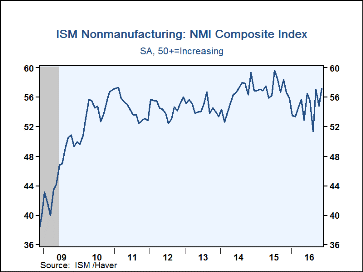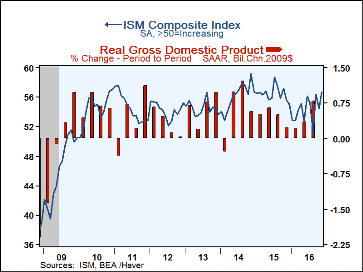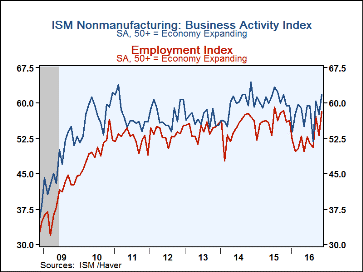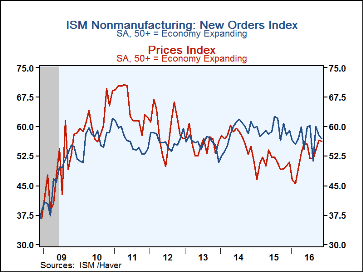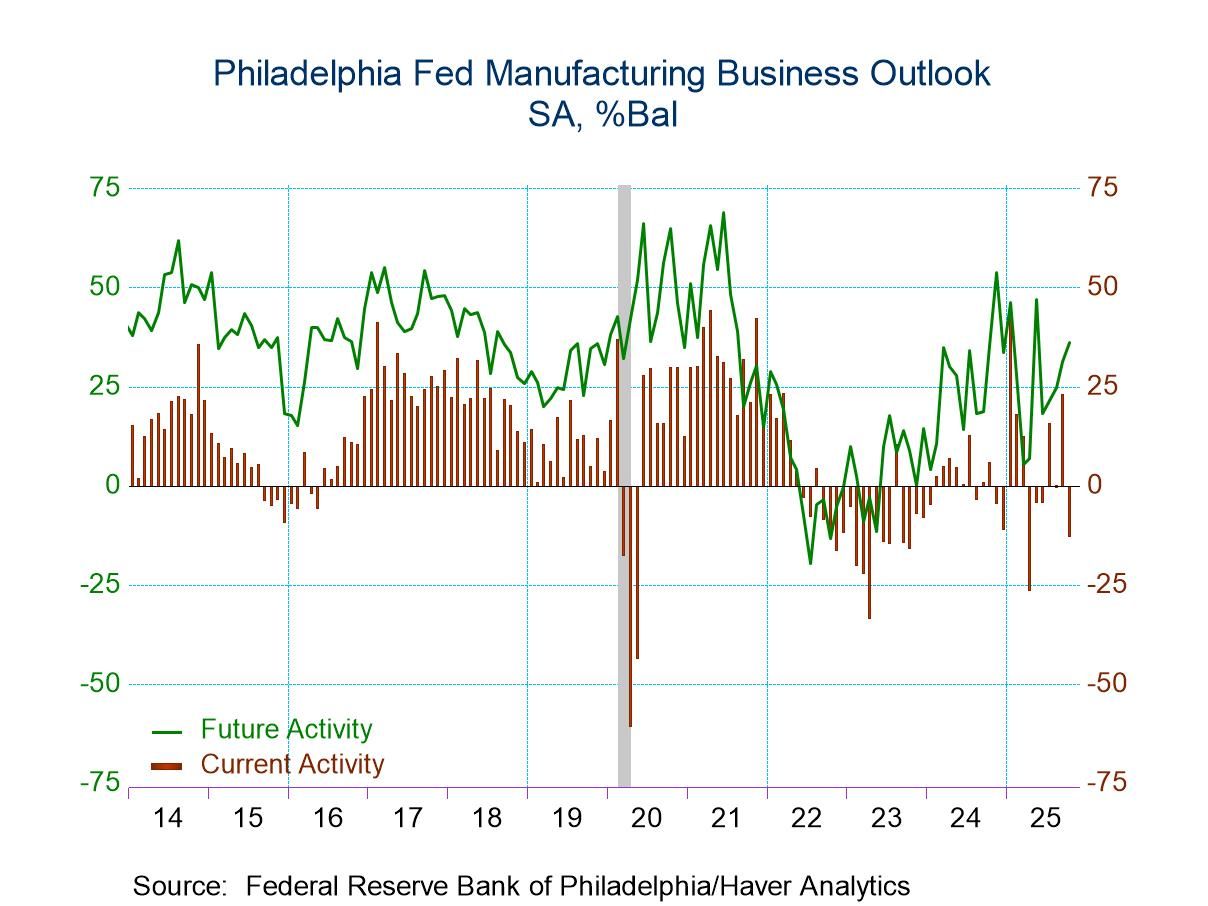 Global| Dec 05 2016
Global| Dec 05 2016U.S. ISM Nonmanufacturing Index Strengthens
by:Tom Moeller
|in:Economy in Brief
Summary
The Composite Index of Nonmanufacturing Sector Business Activity from the Institute for Supply Management (ISM) rebounded to 57.2 during November from an unrevised 54.8 in October. The latest level was the highest since October 2015, [...]
The Composite Index of Nonmanufacturing Sector Business Activity from the Institute for Supply Management (ISM) rebounded to 57.2 during November from an unrevised 54.8 in October. The latest level was the highest since October 2015, and compared to expectations for 55.5 in the Action Economics Forecast Survey. The ISM data are diffusion indexes where readings above 50 indicate expansion.
Haver Analytics constructs a Composite Index using the nonmanufacturing ISM index and the ISM factory sector measure that was released Thursday. This Composite increased to 56.7 from 54.5, and also was the highest level since October. During the last ten years, there has been a 73% correlation between this index and the q/q change in real GDP.
Performance amongst the nonmanufacturing components was mixed last month. The business activity index jumped to 61.7, the highest level since October. Employment improved to 58.2 and made up September's sharp decline to 53.1. During the last ten years, there has been a 96% correlation between the employment index and the m/m change in service plus construction payrolls. The supplier delivery index rose to 52.0, indicating the slowest order delivery speeds since June. The new orders series eased to 57.0 from 57.5.
The prices paid series fell to 56.3, but remained near the two-year high. Twelve percent (NSA) of respondents paid higher prices while seven percent paid less.
The export order series improved to 57.0, the highest level since March. The imports series also increased to 54.0, a five-month high. The order backlog measure declined 51.0 following two months at 52.0. Each of these last few readings is not seasonally adjusted.
The figures are available in Haver's USECON database. The expectations figure from Action Economics is in the AS1REPNA database.
The U.S. Economic Outlook and the Implications for Monetary Policy is the title of today's speech by N.Y. Fed President William C. Dudley, and it can be found here.
| ISM Nonmanufacturing Survey (SA) | Nov | Oct | Sep | Nov'15 | 2015 | 2014 | 2013 |
|---|---|---|---|---|---|---|---|
| Composite Diffusion Index | 57.2 | 54.8 | 57.1 | 56.6 | 57.1 | 56.2 | 54.6 |
| Business Activity | 61.7 | 57.7 | 60.3 | 59.4 | 60.8 | 59.7 | 56.6 |
| New Orders | 57.0 | 57.7 | 60.0 | 57.9 | 59.2 | 58.6 | 55.8 |
| Employment | 58.2 | 53.1 | 57.2 | 56.0 | 56.1 | 54.9 | 54.3 |
| Supplier Deliveries (NSA) | 52.0 | 50.5 | 51.0 | 53.0 | 52.5 | 51.8 | 51.7 |
| Prices Index | 56.3 | 56.6 | 54.0 | 50.0 | 50.7 | 56.8 | 55.7 |
Tom Moeller
AuthorMore in Author Profile »Prior to joining Haver Analytics in 2000, Mr. Moeller worked as the Economist at Chancellor Capital Management from 1985 to 1999. There, he developed comprehensive economic forecasts and interpreted economic data for equity and fixed income portfolio managers. Also at Chancellor, Mr. Moeller worked as an equity analyst and was responsible for researching and rating companies in the economically sensitive automobile and housing industries for investment in Chancellor’s equity portfolio. Prior to joining Chancellor, Mr. Moeller was an Economist at Citibank from 1979 to 1984. He also analyzed pricing behavior in the metals industry for the Council on Wage and Price Stability in Washington, D.C. In 1999, Mr. Moeller received the award for most accurate forecast from the Forecasters' Club of New York. From 1990 to 1992 he was President of the New York Association for Business Economists. Mr. Moeller earned an M.B.A. in Finance from Fordham University, where he graduated in 1987. He holds a Bachelor of Arts in Economics from George Washington University.


